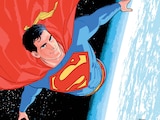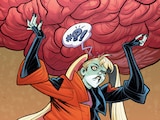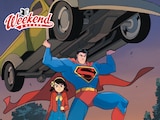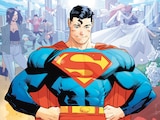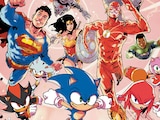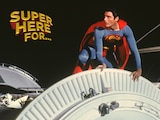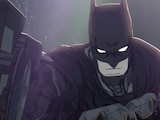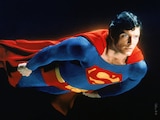When you think about the artists who have truly defined Batman over the past decade, a few names always rise to the top. One of them, of course, is the mononymed Scottish artist Jock, whose unique expressionist style and collaborations with Scott Snyder have morphed the Dark Knight into an almost ethereal figure. Now, under the always creator-conscious DC Black Label imprint, Jock finally has his own Gotham story to tell—Batman: One Dark Knight, an ordeal which takes a gadget-deprived Batman in a dash across a darkened Gotham with the entire city on the line. With the first issue now in stores, we sat down with Jock to talk about the versatility of Batman, the artist-to-writer/artist pipeline, and one extremely vital question we couldn’t help but ask right away.

I’d like to start by addressing the thing that most people want to know about you. Not many superhero comic artists have secret identities themselves. I’ve read that it began as a childhood nickname, but why do you professionally go by the name “Jock?”
So, it was a childhood nickname. And as I was growing up, I naturally signed my artwork with my nickname. But more so, it was when I started going to conventions in the early years. This was before the internet. We used to go to conventions over here in the UK with a portfolio under our arm and meet editors. You know, try and show my work around. And in the early days, you get turned away, and get, “Thank you very much, but you know, da da da da da.”
But then, when I’d come back the next year, they’d always go, “Oh, Jock! I remember you!” So it just kind of stuck, to be honest! I started with that name over here in 2000 AD. And don’t get me wrong, when I first got work at DC and Vertigo, I very strongly considered changing back to my real name. Because “Jock” means something very different in the States, right? I mean, you can tell I’m a very sporty person.
(Quick side note here in trans-atlantic lexicography. While we in the United States associate the term “Jock” with a person interested in sports, in the United Kingdom the word is used as a teasing, mildly pejorative term for a Scotsman.)
But my first job for Vertigo was Hellblazer, and the script came in from Mike Carey, and on the first page he had kind of interspersed the credits as part of the story. It just said, “STORY BY MIKE CAREY,” and there was a panel that said, “ART BY JOCK.” And I was like, you know what? I guess it’s written in the stars. So that was it, and here we are.

Never underestimate the power of branding.
Right, right. (laughs)
So, your work with Scott Snyder has made you one of the most recognizable Batman artists in the modern era. But many readers don’t realize how much creative input an artist really has on a project, and how writers often cater scripts to their artists’ strengths. How much story direction in Scott’s Batman comics came from you, or in your collaboration, and what contributions to Batman as a whole until now are you most proud of?
Well, it’s a great question. Scott is incredibly collaborative, and he’s a very open partner to have. He’s always asking if things can be pushed into directions to be a little bit different. But the truth is, even from Batman: The Black Mirror, which was our first project together, the scripts were just fantastic and there was very little that I needed to change or say. Most things were just little visual cues, or slightly expanding scenes, or just adding a bit of air. An extra panel here. But honestly, the scripts were so good. And he’s very open, but...he didn’t need advice from me, let’s put it that way.

In that case, this is really the first time that you’ve told a Batman story yourself, making that transition from artist to writer/artist. When did you start considering that change, and what was the learning curve like?
I mean, it’s something that I always wanted to do, to be honest. A lot of my favorite creators are writer/artists. I think comics literally, as a form, is a very pure way of telling a story. When someone picks up a comic, it’s a very personal thing, and you’re engaging with the writing and the art in a very pure way. I’ve often wondered if as a writer/artist it’s even less diluted and even more direct. It’s something that I’ve always been interested in. Som when the opportunity came up, I just grabbed it with both hands.
It isn’t lost on me, the privilege to get to work on a character like Batman and the legacy that he has, and the amazing people that have come before me. It’s been absolutely fantastic. There have been elements that have been a learning curve, with the writing. Very specifically, I tried to use a simple story that I felt like I could do very effectively rather than trying to be too ambitious, trying to be too much, you know? This is a very simple story told over one night, and that’s what I wanted to do.

It may be a simple story conceptually, but it is doing some interesting things. Batman is, by a wide margin, the most storied character in all of comics, so it can be hard to find a new thing to do with him. And yet, One Dark Knight seems to stand out from other Batman stories. Do you have any thoughts on how it gives that impression?
I mean, that’s very kind of you to say, Alex, because I bet you’ve read a lot of Batman comics. (laughs)
I would say, coming back to what I was talking about, trying to choose a simple concept, a simple plot. I feel like the elevator pitch is very strong. It’s basically, “Batman is abandoned in Gotham. He hasn’t got any of his toys. He hasn’t got Alfred in his ear. In the middle of a blackout, he’s got to get from A to B before dawn because something very terrible will happen at dawn if E.M.P. is exposed to sunlight.” And it’s called One Dark Knight!
Speaking of E.M.P. This is a new character. What can you tell us about this villain who sets the story’s events in motion? Who is E.M.P. as a person?
Yes, so he’s “Edward M. Pressler.” That’s where the E.M.P. name comes from. He is a “villain.” He’s a metahuman. He’s certainly been involved with villainous activity in the past. But in this story, there’s something more tragic about him. Five years ago, something happened, which essentially turned him into a slightly tragic character, but it also makes him very dangerous. Very volatile. So, Batman is shepherding him, but also, Batman sort of wants to help him, because of his tragic side. And for me, there was just something quite interesting in that dynamic. All the while, multiple gangs and people from Gotham are constantly bearing down on them. So E.M.P. is a volatile, unstable, tragic, dangerous character to have out in the open, at your side, in Gotham City. And that’s what I wanted to bring to him.

Artistically, One Dark Knight seems to be a book of contrasts. There’s a level of hyper-realism to the weapons and vehicles of the story, which stands against this fantastic, larger-than-life figure of Batman himself. What are you trying to convey in the relationship between Batman and his surroundings?
I’m glad that’s what you got from it because that’s what I tried to bring to it. You know, very early on, I had to decide what role Batman was going to play in this story. And by that what I mean is, he can be Bruce Wayne. He can be a guy in a suit. He can be a superhero. He can be the detective. He can be a silent detective. He can be almost like an ethereal, scary kind of demon of the night. He can be so many things. And I think the strength of him is that he can carry that stuff to start with—he can be slightly larger-than-life.
I’ve always loved stories where there are some grounded elements, but they’re sort of turned up to eleven a little bit. This is comics, after all, and we can embrace the sort of hyper-real nature of it all. And I love drawing that stuff, I love it to feel gritty and grounded, but also big and bombastic as well. I think the first series I did with DC, The Losers with Andy Diggle, straight off the bat, that was our remake. We were gonna make it feel real, but larger than life as well. And that’s always stuck with me. Coming from 2000 AD, they tend to be kind of propulsive, bombastic stories. But hopefully in the way that I draw Batman, and the way that I represent the world, it kind of grounds it as well. So, I’m hoping to tick both boxes.

Now that you’ve finished writing and drawing Batman: One Dark Knight and taking that first simplified step into the Writer/Artist world, is that something you’re looking to pursue more, as a solo act? Are you “Jock, Writer/Artist” now?
I would definitely be open to doing more, for sure! But I’m also always talking to Scott about new projects. I’m very lucky to be friends with a number of amazing writers that I’ve collaborated with, and there’s something special to that as well. But I’m absolutely open to doing more for sure, yeah. I mean, let’s see how this goes, eh?
Batman: One Dark Knight #1 by Jock is now available in print and as a digital comic book.

